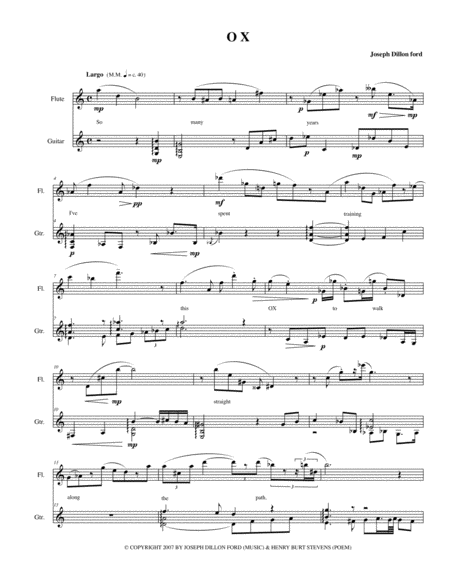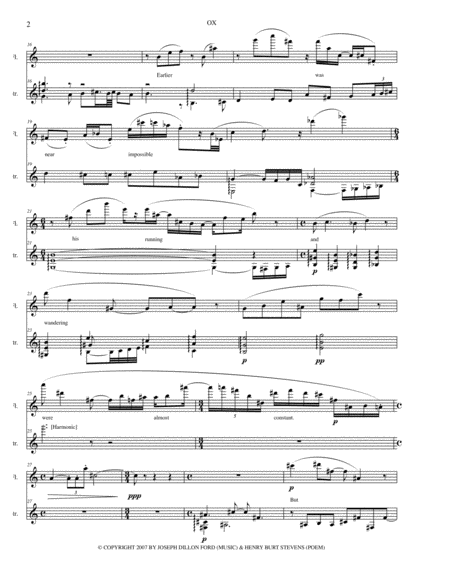Small Ensemble Flute,Guitar,Voice - Level 3 - Digital Download
SKU: A0.958482
Composed by Joseph Dillon Ford. 20th Century,Contemporary. Score and parts. 3 pages. David Warin Solomons2 #3692473. Published by David Warin Solomons2 (A0.958482).
An intensely contemplative chromatic setting for flute and guitar of Henry Burt Stevens's poem of the same name. (Between five and six minutes in duration.)
The poem is:
"So many years I've been training this ox to walk straight along the path
Earlier was impossible
His running and wandering were almost constant
But lately he walks slower
Much steadier and not so far ahead of me"
"OX" is a work for solo flute and guitar based on the poem of the same name by Henry Burt Stevens. The poem in question, written on 13 June 2000, appeared in an edition of Stevens's chapbook Victory published by Vico Press on 15 May 2004.
Ford had been previously commissioned by Stevens to compose music for the 2005 DVD version of Victory. "OX," however, is an entirely new work created (along with a choral setting of Stevens's poem "Surrender") during the week of 11 February 2007 for inclusion in the Delian Suite No. III (2007), a collaborative project featuring choral and instrumental movements written and performed by members of the Delian Society. A musical gift acknowledging the poet's good will and generous support for the Delians, "OX" is dedicated to Stevens and to the artists who premiered it-flutist Michelle LaPorte and guitarist Gerry Saulter of the Serenade Duo, St. James, New York.
"OX" is a movement of moderate length conceived in a highly chromatic late-romantic idiom with frequent modulations and occasional digressions into regions that strike the ear as mysteriously atonal. But this describes only the aesthetic surface of a work whose underlying structure embodies the very letter and spirit of Stevens's poem.
The text consists of three three-line stanzas in free verse, a form reflected in the three parts of Ford's musical realization (mm. 1–16, mm. 17–28, and mm. 29–51). Each word of the poem actually has a melodic equivalent in the solo flute part, thanks to Ford's use of "Chromatic One," a technique of his own invention that allows any literary text written in the letters of the Roman alphabet to be transliterated into musical notation. The resulting melodic line is thus rendered in a musical "dialect" of the original English, such that each performance represents a recitation of the poem. Chromatic One is a very precise technique whereby each letter of the alphabet is assigned to a particular ascending or descending melodic interval. By interlocking these intervals, entire words are produced, and through the use of successive unisons or octaves, Chromatic One makes it possible to distinguish one word from the next and to effect register changes that are sometimes necessary to remain within the range of the reciting instrument.
Deriving the principal melody in this manner from the original text was only the very beginning of a creative process that resulted in a musical composition that communicates the essential meaning of the poem. Although listeners whose ears have been trained to interpret the various melodic intervals used in Chromatic One could understand the literal meaning of the principal melody if it were recited at a slow to moderate tempo, the chromatic dialect itself is intended primarily for musico-poetic purposes. By specifying that the original English text be displayed during performance, the composer is freed to fashion a truly artistic interpretation of the poem that is restricted neither by tempo nor by the addition of accompanying material that serves to amplify the meaning of the words.
In Zen (Chan) Buddhism, stories about the ox and oxherd have been used for centuries to describe the "path" to enlightenment, and this tale has been recounted in various series of "ten oxherding pictures." Although there are different versions of.
This product was created by a member of ArrangeMe, Hal Leonard’s global self-publishing community of independent composers, arrangers, and songwriters. ArrangeMe allows for the publication of unique arrangements of both popular titles and original compositions from a wide variety of voices and backgrounds.
About Digital Downloads
Digital Downloads are downloadable sheet music files that can be viewed directly on your computer, tablet or mobile device. Once you download your digital sheet music, you can view and print it at home, school, or anywhere you want to make music, and you don’t have to be connected to the internet. Just purchase, download and play!
PLEASE NOTE: Your Digital Download will have a watermark at the bottom of each page that will include your name, purchase date and number of copies purchased. You are only authorized to print the number of copies that you have purchased. You may not digitally distribute or print more copies than purchased for use (i.e., you may not print or digitally distribute individual copies to friends or students).
 Instant Download
Instant Download


 Share
Share